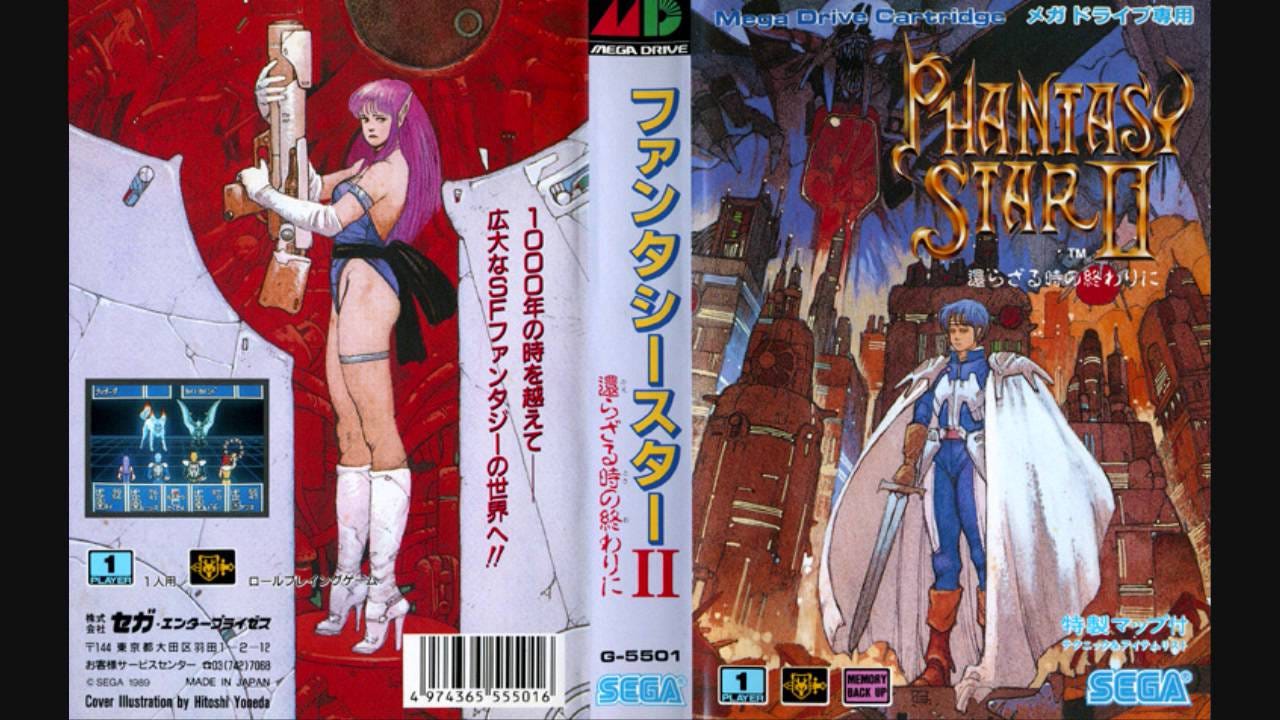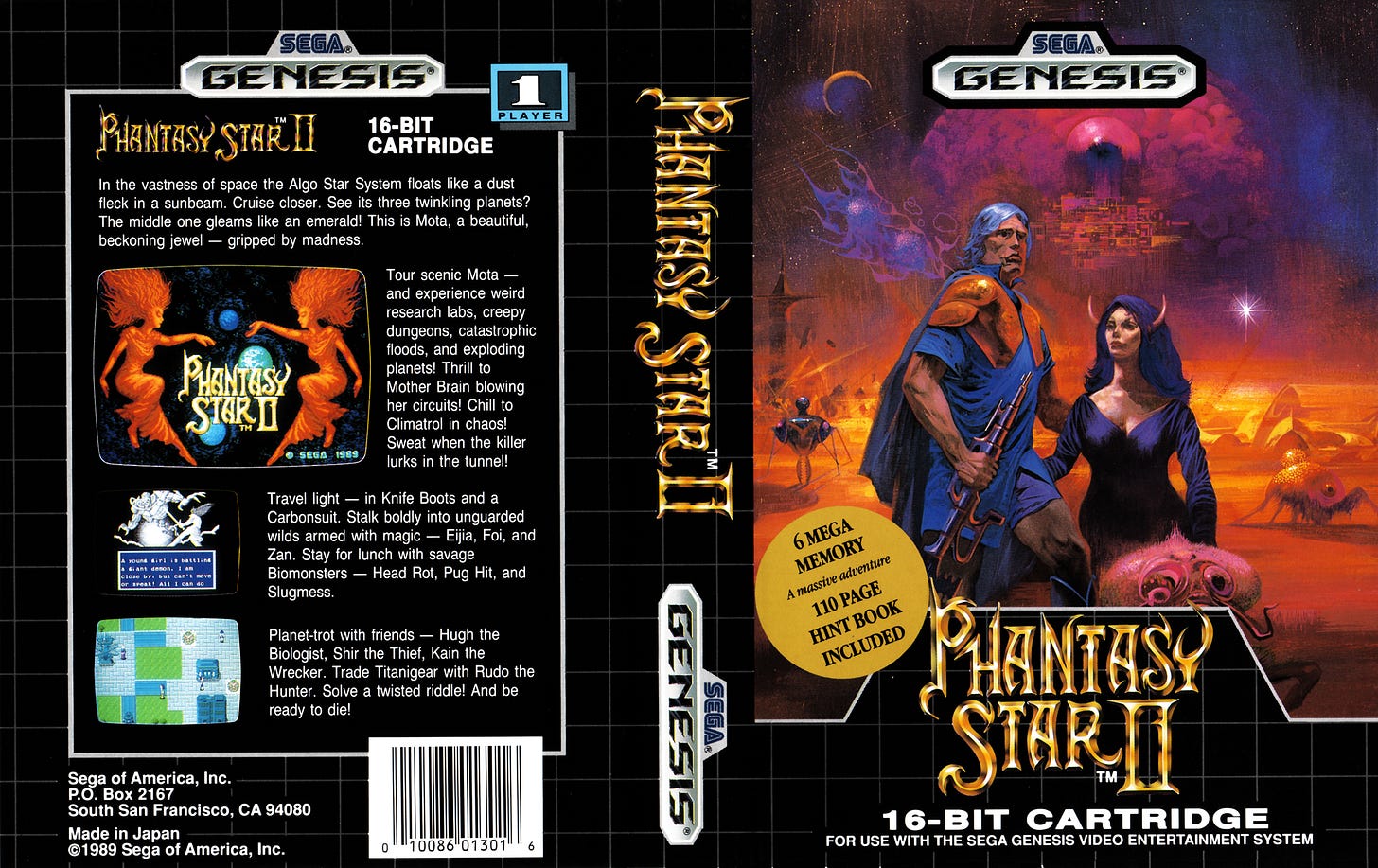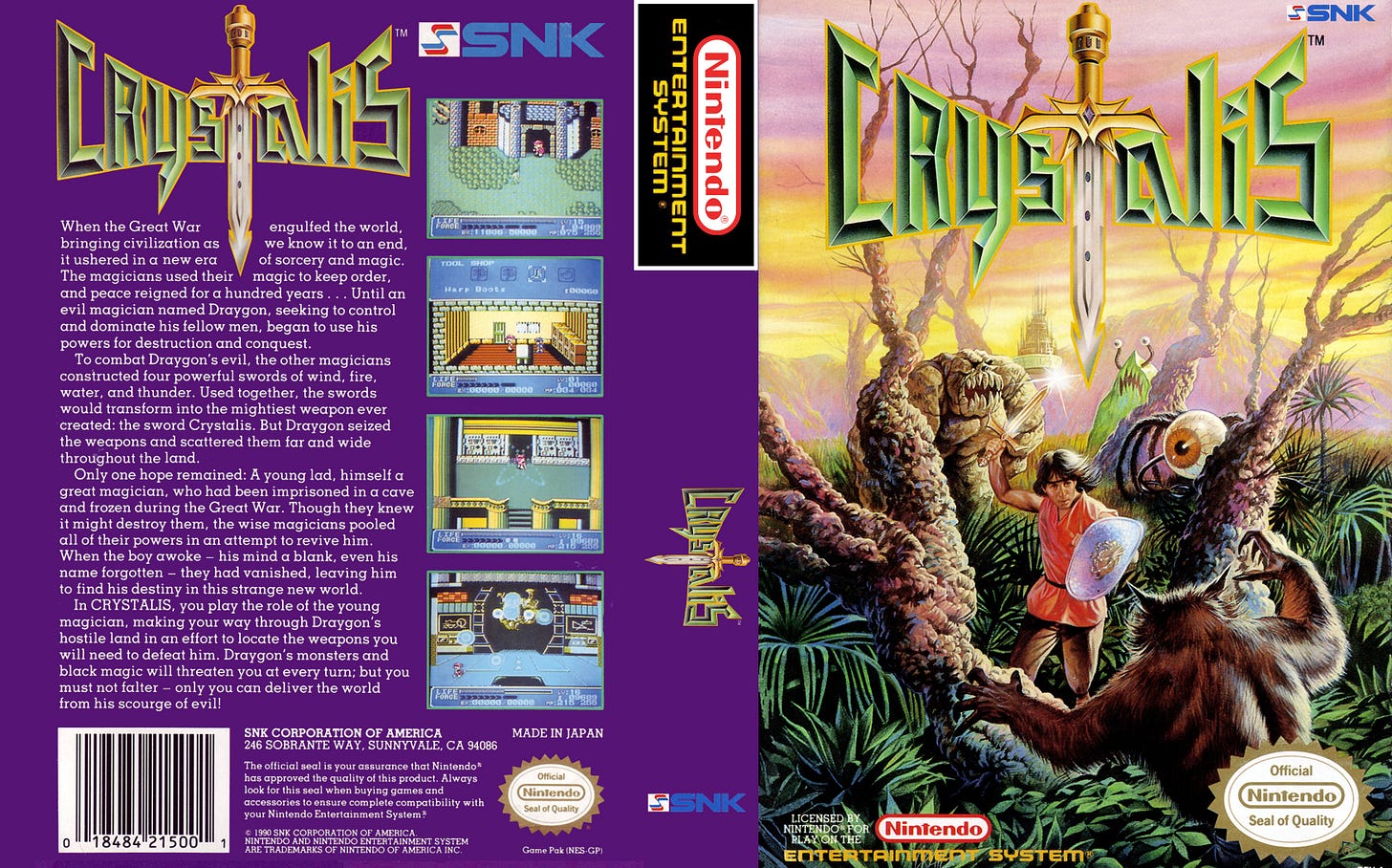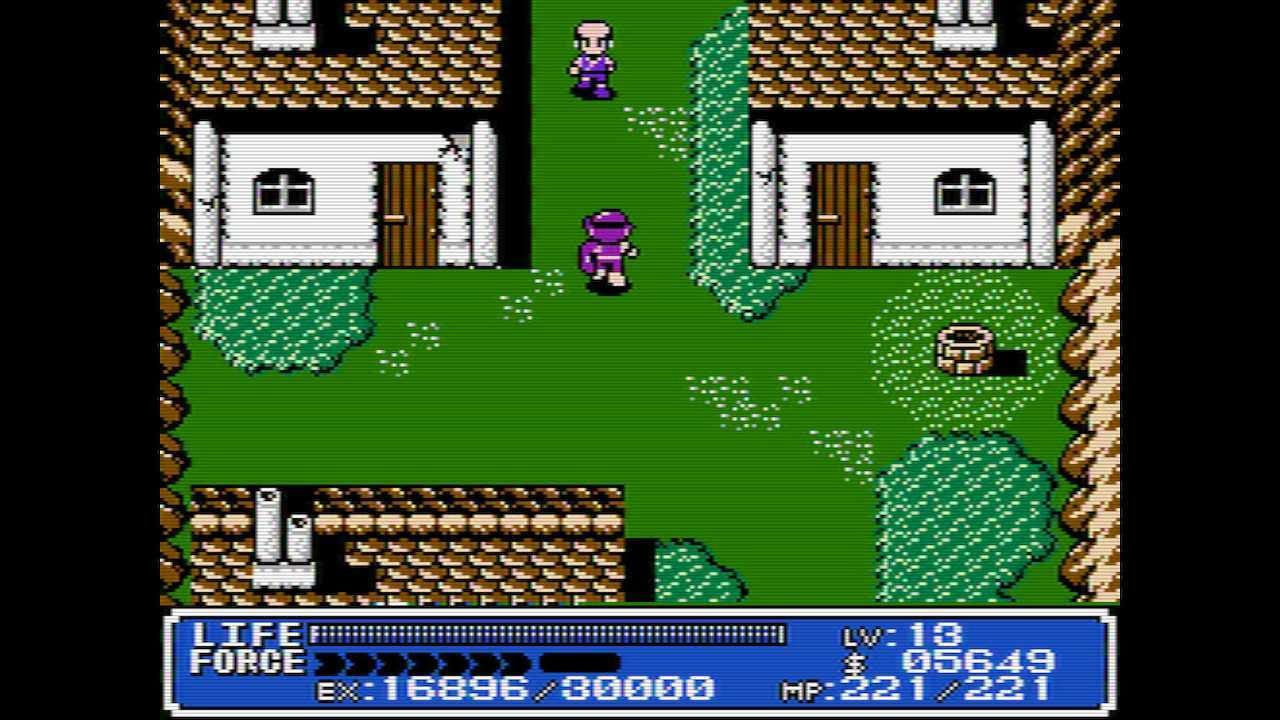Retro Spotlight: Crystalis
SNK is known for their fighters and run and gunners, but once upon a time, they made an action RPG for the NES, too.
This column is “Retro spotlight,” which exists mostly so I can write about whatever game I feel like even if it doesn’t fit into one of the other topics you find in this newsletter. Previous entries in this series can be found through this link.
There was a trend in the 1980s and 1990s, a terrible trend. North America was not considered “ready” to embrace Japanese art styles, even if they were ready to embrace Japanese video games, and so, the box art for these games suffered. Nothing ruined the box art of a game and made it more generic than releasing it in the west, with fantasy games often seeing the worst of these changes.
The series that suffered the most to me — or, at least, the one that comes to mind first given my familiarity with it and that it happened to a number of games — you have the differences in the covers for the Phantasy Star art. Phantasy Star takes place in a sci-fi universe that uses guns and beam weapons and beam swords and has android cat ladies with special powers. The characters look like they were inspired by anime-style art, and true-to-form representations of these characters graced the Japanese covers of the games:
The main character is shown with their actual look, hair, cloak, all of it, and the city in the background looks futuristic, and in contrast with the protagonist’s sword, as befits the game. On the back cover, again, a representation of the character you will find within the game. Since that concept was apparently a no go in North America, instead, we got… this:
What is with those faces? What is with their clothing? What weapon is the dude even carrying? There are still hints of the sci-fi elements of the game in the cover, but they’re less obvious and far uglier, and, like the protagonists, do not remind you of the actual art in the game at all.
I bring up an example of this from another game besides the one in the headline to prepare you, so that you can look at how they massacred our boy in the conversion of SNK’s 1990 action RPG, God Slayer, to a name you might be more familiar with: Crystalis. Here is the Japanese art for the game:
A thoughtful, detailed look at the game’s hero and its second most-important character, with the extremely important-to-the-plot floating tower shown in the game’s intro set above an army of ghouls and mutants. The main character (who you are responsible for naming) has a defined look, and while the 8-bit render of him in-game is obviously a bit different looking, this is a totally believable version of that look, when you’ve got more than pixels to work with.
And here is what North America got:
I don’t mind the name change from God Slayer to Crystalis so much: at least Crystalis is a thing that is in the game, and it ended up being less generic than “God Slayer,” which is basically a genre of JRPG unto itself. The choices made in the art, though… that’s another story. Like with Phantasy Star, whoever drew this does not believe armor is a thing that should exist, not should it be notable in its appearance. The character’s hair color has changed from the red of the cover and the red within the game to brown, the shirt is the wrong color and also, it is just a shirt. The protagonist on the Japanese cover art has a flaming sword; North America’s generic-looking protag looks like he’s wielding the blade that was broken while it was still broken. And the enemies, too, all look like generic versions of the much more playfully-drawn foes you find within the game itself.
This style isn’t just ugly, but creates real whiplash once you see what the actual game looks like. Spoiler: like something the Japanese cover art would be based on. Does the North American box art project a vision of a game where you can ride a dolphin across the sea after you help them recover from their injuries? I didn’t think so.
Anyway, the box art is probably Crystalis’ most significant flaw. It’s not that the rest of the game is without issue, nothing like that: it’s more that none of those problems make me as annoyed as looking at the western interpretation of what the game looks like. Maybe it’s good that Japan withheld so many of their RPGs from North America in the 80s and 90s: otherwise, we’d have so many more examples of box art conversions to be upset about.
God Slayer was released on the Nintendo Famicom in Japan in April of 1990 by developer and publisher SNK, less than two weeks before the company’s Neo-Geo home and arcade systems came out. They never did bother porting it over, or releasing a version with enhanced graphics, which makes some measure of sense considering the length of the game didn’t quite fit arcades, and it’s hard to imagine someone wanting to pay for the expensive Neo-Geo cartridge when the Famicom/NES one already existed, even if it was just 8-bit. Still, we can dream about what something with the visual power of the Neo-Geo would have popped out, can’t we?
North America wouldn’t have to wait long for their own version of God Slayer, as Crystalis released in July of the same year. It’s a bit of a mix of elements that were in play in other games at the time: it feels a bit like Ys sometimes in how you travel around dungeons and labyrinths and sections of overworld, with constantly respawning enemies helping you gain experience, levels, and gold, but it’s also not like Ys, as it lacks the rhythm of that game in its fighting. It’s a little more like The Legend of Zelda, because of this. You’re constantly swinging your sword and shooting energy beams from it, and also choosing from a variety of items and spells to both win your battles and progress in the story in a more direct fashion than you would have in early Ys titles.
It’s more like itself than any other game, though, as it blended elements from other titles to become more of its own thing. I said “swinging your sword” above, but it’s really more of a stabbing motion, which means the range of the weapon, and how you approach enemies, is far different than it would be in Zelda. It’s more direct than that, since you have to have the foe right in front of you, and you spend more time attacking from range than you would in the original Zelda, too, thanks to the fact you can charge up your sword to shoot beams of varying spreads and damage capabilities. You can spend a whole lot of time in Crystalis mostly trying to keep distance from oncoming enemies and their projectile while you charge your sword up to deliver a blow from afar.
In addition to trying to keep your distance, you need to bring the right sword into battle. There are four of them in the game, all elemental: wind, fire, water, and electric. Some foes are immune to all damage save one sword, some let you slash at them with a couple of different ones: figuring out which blade works against which enemies is part of the battle system, and you will find yourself switching back and forth between your swords pretty regularly, both in and out of battle. The swords also have accompanying equipment with them that allow you to shoot more powerful beams from them, with the level three beams being these large-scale attacks that consume magic points, while the level two beams are used to clear certain environmental objects and puzzles. Freezing water into a small bridge, blowing away rubble to open a passage, burning down obstacles in your path, calling down lightning to destroy demon walls that shoot fire at you. Normal stuff.
Constantly going back to the menu to switch your swords and spells can be a bit annoying, and the limitations of a controller with just two face buttons on it becomes very apparent while trying to recall which items use which button when equipped. You can’t have both a spell and an item like the rabbit boots that let you jump equipped at the same time, for instance. Well, you can equip them both, but the spell will take precedence, as both are assigned to the same face button. If Crystalis had waited just one more year and been released on the Super Nintendo instead, all of these issues would have been solved by incorporating the extra Y and X buttons, as well as the L and R shoulder buttons: all of the various item types could have had their own dedicated cross button, and you could have switched between your different swords without opening the menu using the shoulder buttons. Alas, Crystalis and God Slayer both stayed on their original hardware, until Nintendo licensed it from SNK to release a Game Boy Color port that did not seem to make anyone who played it very happy, especially if they were familiar with the original.
Oh, and you have to figure out what items like said rabbit boots do on your own: the game does not tell you. Something like the antidote is easy enough to sort out — Crystalis is rife with enemies that deal status effects, and the antidote to poison connection does not take very long to make. The fruit of repun, though, what is that supposed to be? Oh, well that changes you back into human form if you are magically cursed into being a monster. The fruit of lime? Well that cures petrification. The best you’ve got is to assume whatever new herb or fruit is in a new town’s shop is the cure for whatever new status effect is inflicted upon you, but even a minor text description would have been welcome.
The same goes for the repeat-use items like your gear, too. You can get a Shield Ring, which you assume helps your defense, and it does. But only your ranged defense. You need the iron necklace if you want to increase your melee defense. You don’t know what the leather boots are for when you get them, but if you equip them and then walk over poisoned marshes or spikes, you won’t take damage. I only know this because it’s 2021 and there are entire pages dedicated to telling you how things work in games like Crystalis. Luckily, the event items you collect are a bit easier to figure out the use for, since you often have to deploy them almost immediately after acquiring them, but your gear is often a real mystery even if you employ trial and error.
All of this being said… Crystalis is still worth playing in 2021, even if it’s got a whole bunch of inconvenient-even-for-1990 in it. The game’s NPCs aren’t just nameless old men hanging out in caves to hand you items or give you advice, but are actual characters with real roles to play, characters you’ll see again and again and need to understand in order to progress. There are parts of the game that require you to use a magic called “Change,” which lets you change form into various other characters in the game. Sometimes it’s as easy as “disguise yourself as a woman to gain entry to the Amazon village,” and sometimes it requires you think of the relationships a certain character in the game might have to people of a particular city, in order to gain entry to it or collect a necessary item from them.
Once you get the hang of how your swords work, combat works well, and it’s fun to start blasting away foes with high-level beams from a distance. Leveling up is never really a grinding process, either, which is welcome: just don’t run from the foes in front of you, and you’ll be mostly fine on that front, and if you must run, just be sure not to do so when you find the enemies handing out inordinate amounts of experience when they expire. That’s how you catch up in a hurry if you are behind. I finished the last couple of dungeons in the game without needing to fight any enemies at all, which let me focus more on the labyrinthian nature of those stages, as I had already hit the level cap of 16 earlier, and without spending all that much time fighting enemies I didn’t absolutely have to.
You won’t have to spend much time backtracking or trying to figure out what to do next, either, thanks to it being made clear from the start that you should talk to all of the NPCs you meet — there aren’t so many of them that this is a burdensome task — and because of your Telepathy magic. This spell passively lets you commune with animals and those who speak other languages, but more actively, lets you reach out to the various wise men and women of the game in order to get their advice on where to go next. You can also teleport to any city you’ve previously been to, which makes backtracking feel like less of a chore, and there are items to help you do this, too, just in case you’ve spent all of your magic points healing yourself or talking to wise men with your mind or just from blowing shit up.
The story is enjoyable as well, to the point that changes to it in the aforementioned GBC iteration of the game aggravated fans, as those changes made it more generic. Crystalis actually takes place in the future, after a dystopian event in 1997 sees the world give up on technology in favor of magic. The remnants of the old world are contained within a floating tower capable of obliterating humanity if it turns out that they really just aren’t capable of avoiding another conflict like the Great War that nearly ended civilization in the past: that tower awakens in the year 2097, and so to does Crystalis’ protagonist. You’ll discover their link to the past, that this “hero of legend” has been kept in stasis for the past 100 years to for a specific purpose in the future, and that it’s time for him and one other to make a decision on that task in the present. The more sci-fi elements are contained more within the beginning and end of the game, with the middle of this action RPG sandwich focused much more on the fantasy aspect, but it all works.
Like with the button layout, it could use an update that would help it work even better, but so long as you don’t need everything explicitly explained to you, it works well as is, too.
Crystalis is relatively widely available these days. You can pick up an actual NES cartridge for around $30 if that’s your pleasure, but you could also play for “free” if you’re a Nintendo Online subscriber, as it is on the NES channel of that service, or you could pay the $40 for the SNK 40th Anniversary Collection on either the Switch or Playstation 4 digital storefronts, and get not just Crystalis, but a whole bunch of other pre-Neo-Geo SNK titles, too. I played the version of Crystalis in that collection this time around, and it was my favorite go at the game. Having the four cross buttons helped quite a bit — they aren’t used exactly like I described in the hypothetical, no, but going back to a straight two-button layout feels like it would kind of suck now after experiencing this version of things — but most importantly, the quality-of-life features made ignoring all of the more dated aspects easy.
There’s a rewind feature in the game, pretty typical of emulation these days as well as works by developers like Digital Eclipse that specialize in the kind of re-release/preservation going on with the 40th Anniversary Collection, which you just press the L shoulder button to use. There are myriad uses for such a feature in a game like Crystalis, and if you’re open to rewinding, you’ll find them all on your own. You can also save (or simply pause and put your system to sleep) whenever by going to the game’s menu instead of Crystalis’ menu, and if you want to see the Japanese box art instead of the atrocious North American art for a minute, you can do that, too:
My only complaint there is that you can’t use the Japanese game’s border with the North American version of the game: I enjoy those borders, since I do not stretch these old beauties designed for CRT screens to fit widescreen HD ones, but I can’t look at Generic Knight With No Armor Wielding A Kitchen Knife for 10 hours while I save the world.
Speaking of how the game looks, the 40th Anniversary Collection edition lets you play with the sharpest resolution if you want, which also has the smallest picture, or you can play like I did in the screenshots included in this article, where the image is made to fit top to bottom on the screen, but is pillarboxed on the sides. My eyes aren’t good enough for the smallest picture, but they’re too good to enjoy stretching pixels to take up the whole HD screen.
Crystalis could use a remake, sure, the light touch kind where you can switch between the old 8-bit game and the remade version with the press of a button, as what it mostly needs is some button layout love and the occasional translation fix. It’s still a good way to spend 8-10 hours as is, though, especially if you have SNK’s 40th Anniversary Collection, where it is easily one of the top titles included. Are there better action RPG and action-adventure games out there from the same era? Sure! Crystalis is still worth playing and remembering even if it’s lesser in comparison to a few other titles frmo the time, though, because it got plenty right and impressed with its ambition, even if it the execution wasn’t always perfect. Like I said before, the worst part of the game in 2021 is the box art. And you don’t have to look at that for very long.
This newsletter is free for anyone to read, but if you’d like to support my ability to continue writing, you can become a Patreon supporter, or donate to my Ko-fi to fund future game coverage at Retro XP.










